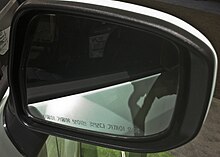Objects in mirror are closer than they appear



The phrase "objects in (the) mirror are closer than they appear" is a safety warning that is required to be engraved on passenger side mirrors of motor vehicles in many places such as the United States, Canada, Nepal, India, and South Korea. It is present because while these mirrors' convexity gives them a useful field of view, it also makes objects appear smaller. Since smaller-appearing objects seem further away than they actually are, a driver might make a maneuver such as a lane change assuming an adjacent vehicle is a safe distance behind, when in fact it is quite a bit closer. The warning serves as a reminder to the driver of this potential problem.
In popular culture
Despite its origin as a utilitarian safety warning, the phrase has become a well known catch phrase that has been used for many other purposes. These include books, films (including non-English ones), cartoons, songs, music albums, and other contexts.
See also
- Vehicle blind spot – Area around vehicle that cannot be directly observed by the driver while at the controls
- Blind spot monitor – vehicle-based sensor device
- Parking sensor – Proximity sensor
- Pedestrian safety through vehicle design – prevention and reduction of injuries in the event of a collision between pedestrians and passenger cars.
- Rear-view mirror – Mirror in vehicles that allows the driver to see rearwards
- Road traffic safety – Methods and measures for reducing the risk of death and injury on roads
- Mind the gap – Warning to train passengers boarding and disembarking, another safety warning used at various London Underground stations that has also become a well-known catchphrase.